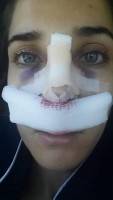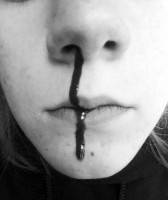Chronic nosebleeds after rhinoplasty
Although uncommon, a possible risk after rhinoplasty is to have a nosebleed.
In your case, you would best be served by being evaluated by a board-certified plastic surgeon with a great deal of experience in rhinoplasty and septoplasty.
It is possible that you may be having some difficulty healing on the inside of the nose which can be creating some of the drainage and bleeding.
An experienced plastic surgeon will be able to examine the inside and outside of your nose and help determine what is the cause (Pat Pazmino, MD, Miami Plastic Surgeon)
Dry nose treatment after rhinoplasty.
Humidification and vaseline on the septum will improve this. You might see another ENT to make sure you don’t have part of the septum sticking out into your airway inside your nose.
Using a vaporizer in your bedroom can do wonders. (Toby Mayer, MD, New York Facial Plastic Surgeon)
Crusting with or without nasal bleeding isn’t common after rhinoplasty. When it occurs it usually means there were changes to the interior of the nose when the rhinoplasty was done.
In other words a Septoplasty and possibly a partial turbinectomy were also done. There are several possible explanations. The septum may still be crooked or deviated. There may be too much space in the nasal channels. There may be a hole or perforation of the septum.
Conservative treatment like what you have been doing usually resolves these symptoms. However since you haven’t had improvement, you need to visit a nasal specialist for a diagnosis and then a new treatment plan. (Oakley Smith, MD, Toronto Facial Plastic Surgeon)
Nose bleeds long after nasal surgery
Nosebleeds can be related to a nose that does dry out too much. There are many factors that cause a nosebleed and can be all addressed by an ear, nose, and throat surgeon. Acute bleeding is stopped with silver nitrate and packing if it is severe.
If the nasal airway is so large that it dries out and never heals and continues to crust, this is related to some type of over aggressive turbinate surgery and septoplasty, not a rhinoplasty surgery. Abnormally enlarged nasal airways can cause crusting and chronic inflammation, which leads to nosebleeds.
This can be addressed by silver nitrate cauterization and Vaseline placed on the inside of the nose. A vaporizer or humidifier in the bedroom can also help at night while you are sleeping. It is not a good idea to place any Polysporin inside the nose because many patients are allergic to that ointment. (William Portuese, MD, Seattle Facial Plastic Surgeon)
Nose scabs and bleeding after Rhinoplasty Surgery could be from a septal perforation or nasal vestibulitis.
If you acquired a septal perforation after your Rhinoplasty Surgery, this will often lead to nasal dryness, crusting and bleeding. If you’re experiencing painful scabs along the hair-bearing skin inside your nostrils that bleed with manipulation, then this may be a common condition called nasal vestibulitis. Vestibulitis is easily treated with topical hydrocortisone cream. You should consult a board-certified ENT for definitive evaluation and management. (Eric M. Joseph, MD, West Orange Facial Plastic Surgeon)
Recurrent nosebleeds after rhinoplasty
You could try using a humidifier, but its obvious you have tried several methods that should clear up any minor issues that would cause the bleeding. I would have your nose re-examined with a board certified plastic surgeon who specializes in the nose and an ENT physician to figure out what can be done. It should definitely not take this long for a scab to heal. (Sam Speron, MD, Chicago Plastic Surgeon)
Nosebleeds years after rhinoplasty
Your scabbing and bleeding could be due to an area of chronic dryness, exposed piece of cartilage, or a permanent stitch that is eroding through. A review of your operative note would be helpful. An experienced surgeon should be able to tell what is going on. (Randy J. Buckspan, MD, Austin Plastic Surgeon)
Recurrent nosebleeds should be evauated by a doctor
Nosebleeds that persist following rhinoplasty, septoplasty or even without prior surgery should always be checked by a doctor.
If you had surgery, see your surgeon. There are a number of ways to treat nosebleeds, from humidifiers to ointments to cauterization.
A deviated septum can be a cause for nosebleeds as well as a number of diseases. Nosebleeds can rarely be the first sign of a more serious medical problem.
So, if your nose continues to bleed despite simple measures, seek out an ENT specialist for an evaluation. (Steven J. Pearlman, MD, Encino Facial Plastic Surgeon)
Recurrent Nose Bleeds (Epistasis) After Rhinoplasty
You should be examined by a nose physician (ENT, facial plastic surgeon, or plastic surgeon familiar with the internal nose).
Most common cause of chronic recurrent epistasis following rhinoplasty is a superficial blood vessel that will likely need to be cauterized.
Your physician must make sure that there is no other problem causing your bleeding.
You must keep your fingers and anything else smaller that your elbow out of your nose for your nose to heal without further bleeding. (Michael A. Persky, MD, New York Plastic Surgeon)
Bleeding after rhinoplasty
This sounds like something that needs to be re-evaluated and biopsied. It’s unusual to have a wound that won’t heal after such a long period of time.
I suggest seeing another surgeon if your initial surgeon is not able to see you or cannot determine the cause of your bleeding. (Nina S. Naidu, MD, FACS, Miami Facial Plastic Surgeon)
Suggestions for Post-Rhinoplasty Nosebleeds
Mucopirocin (Bactroban®) ointment applied twice a day for a week will usually take care of this. (Jeffrey Epstein, MD, FACS)


